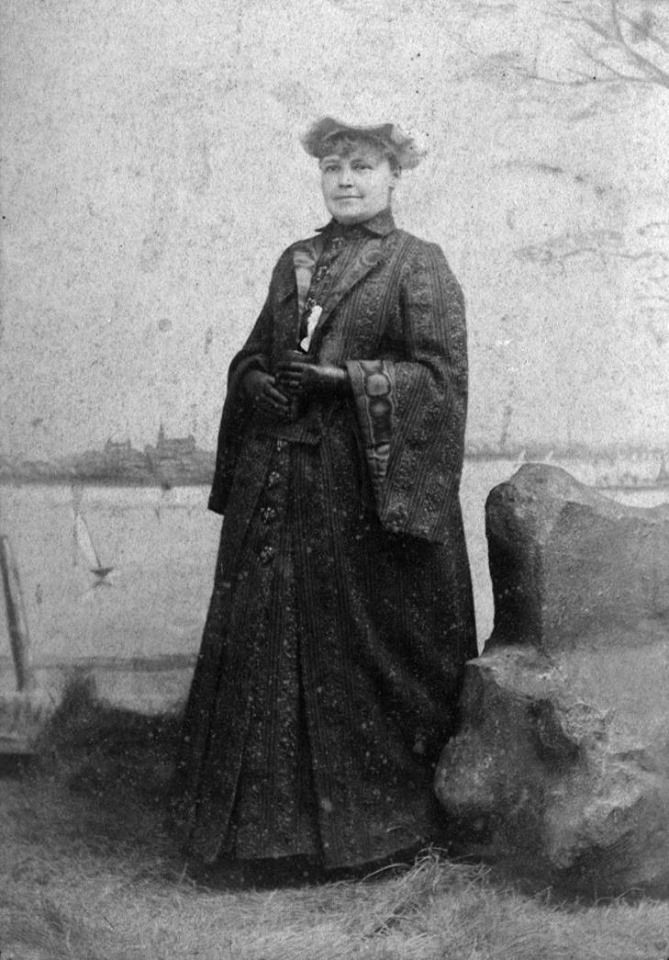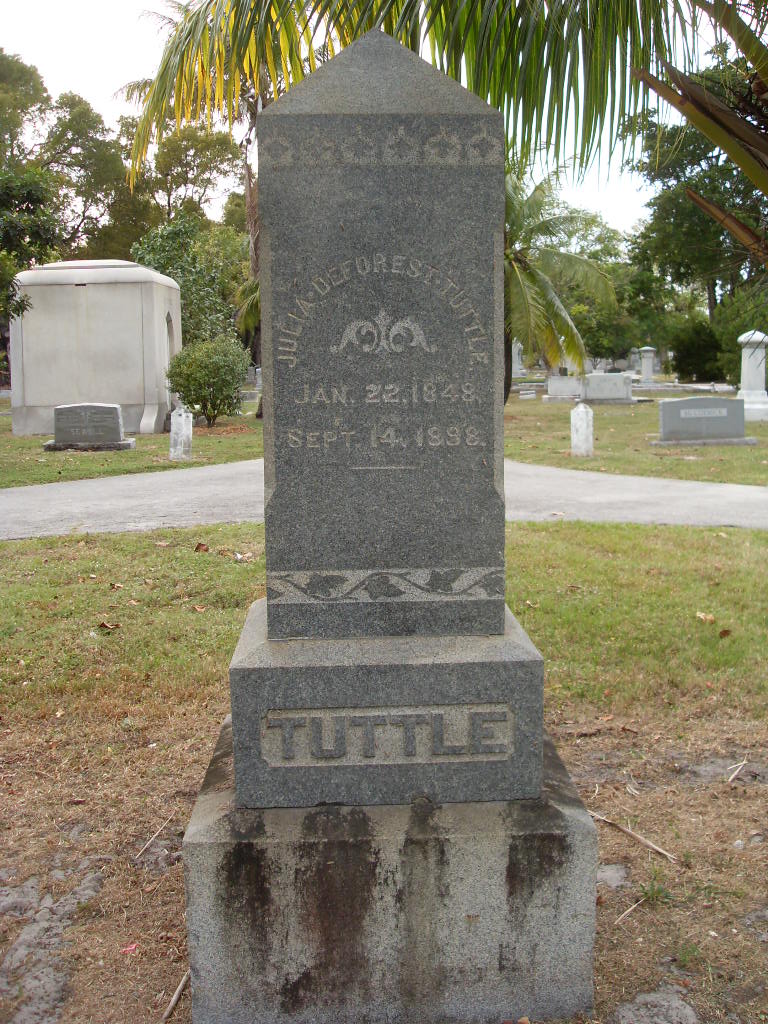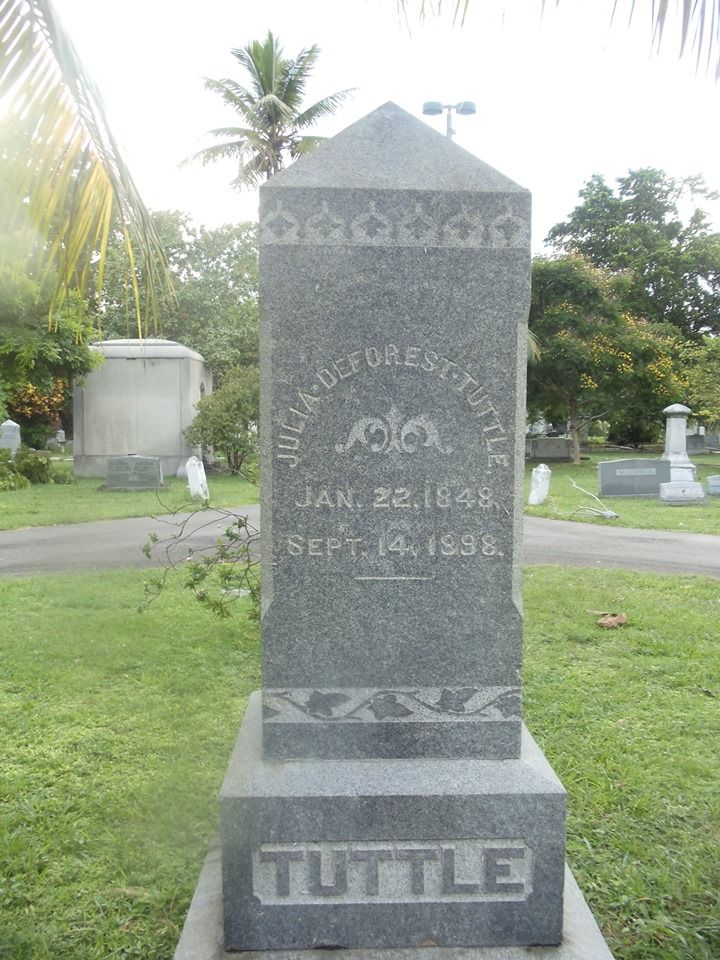She first visited the Biscayne Bay region of southern Florida in 1875 with her husband, visiting a 40-acre orange grove her father had purchased. She loved the experience, but returned to Cleveland, Ohio with her family.
Her husband died in 1886, leaving her the iron foundry he owned, which she was able to keep going. When her father died and left her his land in 1891, she sold the business and returned to Biscayne Bay. She used the money from the business to purchase another 640 acres (2.6 km²) of orange groves along the Miami River, including the old Fort Dallas, which she would convert into a home for entertaining guests. She immediately decided to take a leading role in the movement to start a new city on the river, but knew that decent transportation (in that time, a railroad) was necessary.
She first contacted Henry Plant, a developer of railroads along Florida's west coast. His engineers determined that a connecting route from his existing railroad lines near Tampa through the Everglades to Tuttle's property was not feasible.
She next contacted the Florida East Coast Railroad of Henry Flagler in 1893, making several correspondences to the magnate over the next two years. Each time she was rebuffed. The freeze of February, 1895, however, would finally help to sway Flagler's opinion when Tuttle alerted him that the freeze had spared the Miami River. Legend has it that she sent an orange blossom to him by mail. More accurate accounts contend that Flagler sent Tuttle an associate, who then had vast amounts of citrus shipped back to Flagler as proof of its agricultural survival. Flagler himself arrived in March of that year and was won over rapidly, drawing up plans to extend the railroad there immediately. Under the agreement, Tuttle supplied him land for a hotel and a railroad station for free, and they split the remainder of her 640 acres (2.6 km²) in alternating strips.
On April 22, 1896, train service came to the area. On July 28, Miami was chartered. The original Royal Palm Hotel was opened in 1897.
Julia Tuttle died on September 14, 1898. She was one of the first people interred in the City of Miami Cemetery, given a place of honor there. She died leaving a large amount of debt, partly the result of her altruistic land grants to Flagler. Her children sold her remaining land to pay it off.
Julia Tuttle is called the Mother of Miami. Thanks to her persistance, Henry Flagler became known as the Father of Miami. Perhaps ironically, both Tuttle and Flagler were from Cleveland, Ohio.
She first visited the Biscayne Bay region of southern Florida in 1875 with her husband, visiting a 40-acre orange grove her father had purchased. She loved the experience, but returned to Cleveland, Ohio with her family.
Her husband died in 1886, leaving her the iron foundry he owned, which she was able to keep going. When her father died and left her his land in 1891, she sold the business and returned to Biscayne Bay. She used the money from the business to purchase another 640 acres (2.6 km²) of orange groves along the Miami River, including the old Fort Dallas, which she would convert into a home for entertaining guests. She immediately decided to take a leading role in the movement to start a new city on the river, but knew that decent transportation (in that time, a railroad) was necessary.
She first contacted Henry Plant, a developer of railroads along Florida's west coast. His engineers determined that a connecting route from his existing railroad lines near Tampa through the Everglades to Tuttle's property was not feasible.
She next contacted the Florida East Coast Railroad of Henry Flagler in 1893, making several correspondences to the magnate over the next two years. Each time she was rebuffed. The freeze of February, 1895, however, would finally help to sway Flagler's opinion when Tuttle alerted him that the freeze had spared the Miami River. Legend has it that she sent an orange blossom to him by mail. More accurate accounts contend that Flagler sent Tuttle an associate, who then had vast amounts of citrus shipped back to Flagler as proof of its agricultural survival. Flagler himself arrived in March of that year and was won over rapidly, drawing up plans to extend the railroad there immediately. Under the agreement, Tuttle supplied him land for a hotel and a railroad station for free, and they split the remainder of her 640 acres (2.6 km²) in alternating strips.
On April 22, 1896, train service came to the area. On July 28, Miami was chartered. The original Royal Palm Hotel was opened in 1897.
Julia Tuttle died on September 14, 1898. She was one of the first people interred in the City of Miami Cemetery, given a place of honor there. She died leaving a large amount of debt, partly the result of her altruistic land grants to Flagler. Her children sold her remaining land to pay it off.
Julia Tuttle is called the Mother of Miami. Thanks to her persistance, Henry Flagler became known as the Father of Miami. Perhaps ironically, both Tuttle and Flagler were from Cleveland, Ohio.
Family Members
See more Tuttle or Sturtevant memorials in:
- Miami City Cemetery Tuttle or Sturtevant
- Miami Tuttle or Sturtevant
- Miami-Dade County Tuttle or Sturtevant
- Florida Tuttle or Sturtevant
- USA Tuttle or Sturtevant
- Find a Grave Tuttle or Sturtevant















